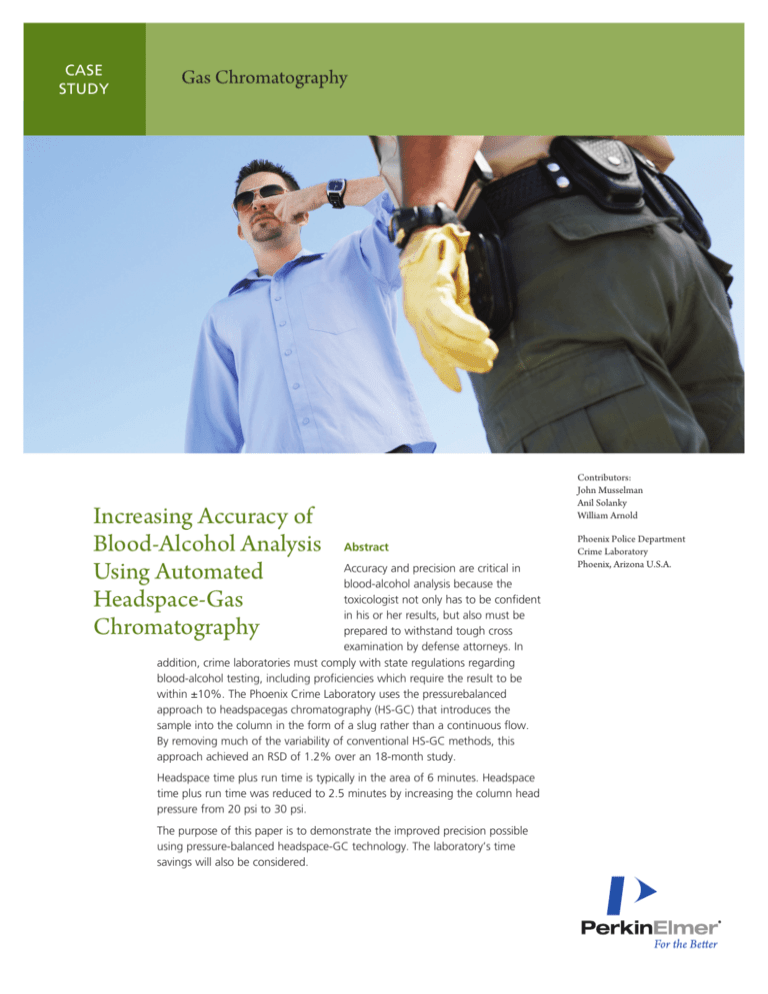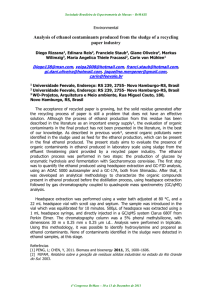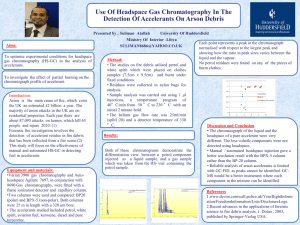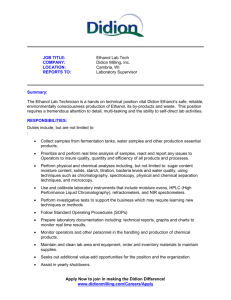
Case
Study
Gas Chromatography
Increasing Accuracy of
Blood-Alcohol Analysis
Using Automated
Headspace-Gas
Chromatography
Contributors:
John Musselman
Anil Solanky
William Arnold
Abstract
Accuracy and precision are critical in
blood-alcohol analysis because the
toxicologist not only has to be confident
in his or her results, but also must be
prepared to withstand tough cross
examination by defense attorneys. In
addition, crime laboratories must comply with state regulations regarding
blood-alcohol testing, including proficiencies which require the result to be
within ±10%. The Phoenix Crime Laboratory uses the pressurebalanced
approach to headspacegas chromatography (HS-GC) that introduces the
sample into the column in the form of a slug rather than a continuous flow.
By removing much of the variability of conventional HS-GC methods, this
approach achieved an RSD of 1.2% over an 18-month study.
Headspace time plus run time is typically in the area of 6 minutes. Headspace
time plus run time was reduced to 2.5 minutes by increasing the column head
pressure from 20 psi to 30 psi.
The purpose of this paper is to demonstrate the improved precision possible
using pressure-balanced headspace-GC technology. The laboratory’s time
savings will also be considered.
Phoenix Police Department
Crime Laboratory
Phoenix, Arizona U.S.A.
INTRODUCTION
Blood-alcohol analysis is typically performed in driving under the
influence (DUI) and driving while intoxicated (DWI) investigations
and in traffic accidents where people have been critically injured
or killed. Most states have “Per Se” laws where it is illegal
to drive while having a concentration of 0.08% or above.
Secondary Per Se levels are not uncommon, i.e., extreme DUI
above 0.15%. With these defined blood-alcohol concentrations,
the accuracy of a system must be assessed. Alcohol analysis is
used primarily to determine the concentration of ethanol and,
to a lesser extent, determine if methanol, acetone, 2-propanol
or toluene is present in blood or urine of “huffers”. HS-GC has
become the nearly universal method of choice for measuring
blood alcohol in foren-sic laboratories because it allows a
relatively large number of samples to be analyzed quickly and
with a minimal amount of manual handling.
identified and quantitatively measured. A single headspace
injection is normally split into two capillary columns, each exiting
to a flame ionization detector (FID). The columns have different
polarity for unique sepa-rations of the volatiles of interest.
Conventional HS-GC systems use a combination of pressure,
temperature and agitation at up to 40 psi to drive solution
components into the headspace. Then, pressure is used to
stream headspace gas continuously into the column, which
tends to reduce the sharpness of the ana-lytical results. Large
numbers of crime laboratories that utilize this method have
typically seen RSD levels upwards of 4%.
Prior to injection, each vial is pressurized to a preset pressure
with carrier gas to ensure that all injections are performed under
the exact same conditions, regardless of different equilibrium
pressures in different samples. During injection, the carrier gas
supply and the needle purge are switched off. Sample flows to
the gas chromatography system from the pressurized headspace
vial. The injected volume is pro-portional to the injection time.
According to Henry’s law, at equilibrium, in a sealed vessel,
volatile compounds in the liquid state will be present in the vapor
state at a concentration proportional to the concentration in
liquid. By sampling this vapor (the headspace) and delivering it to
a gas chromatograph, the volatile compounds may be qualitatively
At the end of the injection, the carrier gas and needle purge are
once more switched on and the injected sample volume is driven
through the gas chromatograph. The needle is retracted and the
system goes into standby mode.
Figure 1. Headspace operation.
2
Several years ago, the Phoenix Crime Laboratory implemented
a pressure-balanced, time-based HS-GC method that
pressurizes the headspace and then releases the headspace gas
instantaneously as a single slug into the column.
This approach is explained in Figure 1. With the injection system
on standby, the carrier gas enters the vial through Valve 1 (V1)
and is directed partly through the heated transfer line to the GC
and partly to the heated needle, which is con-stantly flushed to
avoid cross con-tamination. The needle flush gas exits through
the needle vent valve.
EXPERIMENTAL
Equipment
A PerkinElmer AutoSystem™ XL GC equipped with a
TurboMatrix™ HS 110 headspace sampler, dual FIDs and
TotalChrom® software was used (PerkinElmer part no.
N5150511). The GC was equipped with dual capillary
columns from Restek Corp. The BAC 1-WCOT is a 30 m
long fused-silica column with a 0.32 mm i.d. stationary
phase and 1.8 µm film thickness and the BAC 2-WCOT
is a 30 m long fused-silica column with a 0.32 mm i.d.
stationary phase and 1.2 µm film thickness.
Materials
Internal standard solutions were prepared including:
1. A concentration of 0.015% v/v n-propanol and 0.5 M
ammonium sulfate in deionized water.
2. A qualitative mixed-volatiles standard was prepared by
adding 20 µL acetaldehyde, 80 µL methanol, 20 µL
acetone, 80 µL ethanol and 50 µL isopropyl alcohol
to 100 mL deionized water.
Ethanol calibration solutions with concentrations of 0.025%,
0.050%, 0.100%, 0.200% and 0.400% were procured from
an outside vendor. Positive ethanol controls from a separate
vendor at 0.100% aqueous and 0.190% whole blood
were also procured. A negative control was prepared using
deionized water and the internal standard.
Methods
All calibration solutions, controls and samples were allowed
to come to room temperature before starting. Whole blood
samples were mixed thoroughly before pipetting. Serum
samples required no preparation. Clotted samples were
thoroughly homogenized before pipetting.
A Hamilton Microlab® 500A Series dispenser diluter was
primed with an internal standard solution for at least three
cycles. The left syringe was set to a speed of 4 and used to
deliver 1000 µL of internal standard. The right syringe was
set to a speed of 2 and used to deliver 100 µL of sample.
The dispenser diluter was then used to prepare each
sample, control and calibration solution in duplicate.
Each vial was then sealed and loaded onto the headspace
sampler in the designated sequence. Diluter preci-sion was
determined to be 0.6%.
Samples and calibrators were equilibrated for 13 minutes at 60
˚C and pressurized with helium at 36.5 psig. The sample was
injected into the column in a 0.02-minute period through a 1.3
m x 0.32 mm fused-silica transfer line at 100 ˚C. The cycle time
was 3.2 minutes. The needle temperature was maintained at
70 ˚C and the withdrawal time was 0.2 minutes.
The GC run time was 2.5 minutes and the sampling rate
was set at 12.5 points per second. Oven temperature was
isothermal 45 ˚C and pressure was isobaric 30 psi. Helium
was used as the carrier gas. FIDs were used on each column
with a temperature of 220 ˚C. Gas flows through each
detector were 450 mL/min of air and 45.0 mL/min
of hydrogen.
Elutions on the Restek Rtx® BAC I are as follows:
• Methanol eluted as a single-peak component at 0.716 min
• Acetaldehyde eluted as a single-peak component at 0.790 min
• Ethanol eluted as a single-peak component at 0.877 min
• Isopropanol eluted as a single-peak component at 1.050 min
• Acetone eluted as a single-peak component at 1.269 min
• N-propanol eluted as a single-peak component at 1.374 min
• Toluene eluted as a single-peak component at 5.32 min
With the exception of toluene, all analytes elute prior to 2.5
minutes on both columns.
RESULTS
In order to evaluate the linear range of ethanol quantitation using
this method, a set of 0.025, 0.050, 0.100, 0.200 and 0.400%
ethanol calibration solutions were prepared and run according
to protocol. Spiked samples below and above the cali-bration
solutions were run at the following concentrations: 0.005, 0.010,
0.015, 0.020, 0.600, 0.700, 0.800, 0.900 and 1.000. The sample
was determined to be in the linear range, if the quantitation fell
within +10%. The method was linear from 0.010-1.0%.
The precision, accuracy, limits of detection (LODs) and limits of
quantitation (LOQs) were determined by the following method:
ten replicates of ethanol at concentrations of 0.005, 0.01, 0.100,
0.188 (whole blood control) and 0.400% were run according
to the method described above; accuracy was defined as the
deviations from the actual concentration; precision was defined
as the coefficient of variation (CV) for each of the replicate
concentrations. Precision and accuracy at different concentration
levels are shown in Table 1. The LOD was determined to be
0.005% and the LOQ was 0.010%.
Table 1. Precision and Accuracy at Different Concentrations.
Concentration (%)
0.005
0.010
0.100
0.188
0.400
Accuracy
+13.0%+8.5% -1.8% +0.6%-1.6%
Precision
1.8% 0.4% 0.2% 0.5%0.2%
Within-run precision data
3
The Phoenix Crime Laboratory analyzes approximately 1000 blood
samples per year for alcohol con-centration. Figure 2 shows the
run-run precision utilizing this method over a period of 18 months.
For the target value of 0.1900% ethanol, the average result
was 0.18911 (n=537) with a standard deviation of 0.0023. This
yields an RSD of 1.23%, an upper control limit at three stan-dard
deviations of 0.19697 and a lower control limit at three standard
deviations of 0.18303.
A study was run to evaluate the interferences of other volatile
substances, which may be found in biological fluids either in
the presence or absence of ethanol. Positive interferences were
provided by the mixed-volatiles standard described above. The
peaks were resolved with a resolution better than 1 and a
peak-to-valley ratio better than 90%. This study showed that
acetaldehyde, methanol, acetone, isopropanol, toluene and
methyl ethyl ketone do not interfere with the identification or
quantification of ethanol by HS-GC.
Figure 2. Run-to-run precision over 1.5 years.
CONCLUSIONS
An analytical method was developed to quantify ethanol in blood
alcohol using HS-GC. The method appears to be extremely robust
and reliable and achieved an RSD value of 1.23%, which is well
below those achieved by other methods. RSD values of this level
make it possible for toxicologists to testify with con-fidence that
their results are accurate within ±5%. The result is that DUI
and DWI defendants in the Phoenix area normally plead guilty
to driving under the influence or driving while impaired, saving
the toxicologists the time they would otherwise have to spend
testifying and saving the local government the cost of a trial.
Figure 3. Quantitation column and confirmation column chromatographs.
REFERENCES
1. Rasanen, Ilpo; Ojanpera, Ilkka; Kurkinen, Kaisa; Vartiovaara,
Juhani; Vuori, Erkki. Presentation at 2004 SOFT/TIAFT,
“Alcohol Determination by Head Space Dual Column
Capillary Chromatography.”
2. Christmore, David S.; Kelly, Raymond C.; Doshier, Lonnie
A. Journal of Forensic Toxicology. Volume 29, No. 4, 1984.
“Improved Recovery and Stability of Ethanol in Automated
Forensic Analysis.”
3. Jones, A. W.; Fransson M. Medicine, Science and the Law.
July 2003, Volume 43, No. 3. “Blood Analysis by Headspace
Gas Chromatography: Does a Deficient Sample Volume
Distort Ethanol Concentration.”
4. Andreasson, Rune; Jones, A. Wayne. American Journal of Forensic
Medicine & Pathology. Volume 17, No. 3. “The Life and Work of
Erik M. P. Widmark.”
5. Kancler, Julie. 2003 SOFT Poster 5, “Static Headspace Analysis of
Alcohol and Common Abused Inhalants in Blood Using
Dual-Column Chromatography.”
6. Yazzie, Janice; Luthi, Ruth; Kerrigan, Sarah. 2004 Joint SOFT
Abstract 27, “Effect of Sodium Chloride on Headspace Blood
Alcohol Analysis by GC-FID.”
7. Kristiansen, Jesper; Petersen, Henning Willads. 2003 SOFT Meeting,
Poster 43, “An Uncer-tainty Budget for the Measurement of
Ethanol in Blood by Head-Space Gas Chromatography.”
PerkinElmer, Inc.
940 Winter Street
Waltham, MA 02451 USA
P: (800) 762-4000 or
(+1) 203-925-4602
www.perkinelmer.com
For a complete listing of our global offices, visit www.perkinelmer.com/ContactUs
Copyright ©2013, PerkinElmer, Inc. All rights reserved. PerkinElmer® is a registered trademark of PerkinElmer, Inc. All other trademarks are the property of their respective owners.
007606A_01









